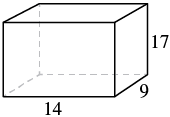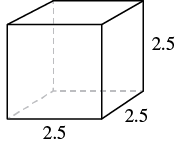- Find the volume of a rectangular solid, sphere, cylinder, and cone
- Find the surface area of a rectangular solid, sphere, and cylinder
Finding the Volume and Surface Area of Rectangular Solids
When we explore three-dimensional shapes, understanding how to calculate the volume and surface area is crucial. Volume measures the space a shape occupies, while surface area describes the total area of all the surfaces of a three-dimensional object. For rectangular solids, which include cubes and rectangular prisms, these measurements are based on the object’s length, width, and height.
volume and surface area of a rectangular solid
For a rectangular solid with length [latex]L[/latex], width [latex]W[/latex], and height [latex]H[/latex]:

How did we come up with the two equations above? Let’s break down a problem to find out.

A cheerleading coach is having the squad paint wooden crates with the school colors to stand on at the games. The amount of paint needed to cover the outside of each box is the surface area, a square measure of the total area of all the sides. The amount of space inside the crate is the volume, a cubic measure.
This wooden crate is in the shape of a rectangular solid. Its dimensions are the length, width, and height. The rectangular solid shown in the image to the right has length [latex]4[/latex] units, width [latex]2[/latex] units, and height [latex]3[/latex] units. Can you tell how many cubic units there are altogether? Let’s look layer by layer.
Breaking a rectangular solid into layers makes it easier to visualize the number of cubic units it contains. This [latex]4[/latex] by [latex]2[/latex] by [latex]3[/latex] rectangular solid has [latex]24[/latex] cubic units.

Altogether there are [latex]24[/latex] cubic units. Notice that [latex]24[/latex] is the [latex]\text{length}\times \text{width}\times \text{height}\text{.}[/latex]

The volume, [latex]V[/latex], of any rectangular solid is the product of the length, width, and height.
[latex]V=LWH[/latex]
We could also write the formula for volume of a rectangular solid in terms of the area of the base. The area of the base, [latex]B[/latex], is equal to [latex]\text{length}\times \text{width}\text{.}[/latex]
[latex]B=L\cdot W[/latex]
We can substitute [latex]B[/latex] for [latex]L\cdot W[/latex] in the volume formula to get another form of the volume formula.

We now have another version of the volume formula for rectangular solids. Let’s see how this works with the [latex]4\times 2\times 3[/latex] rectangular solid we started with. See the image below.

To find the surface area of a rectangular solid, think about finding the area of each of its faces. How many faces does the rectangular solid above have? You can see three of them.
[latex]\begin{array}{ccccccc}{A}_{\text{front}}=L\times W\hfill & & & {A}_{\text{side}}=L\times W\hfill & & & {A}_{\text{top}}=L\times W\hfill \\ {A}_{\text{front}}=4\cdot 3\hfill & & & {A}_{\text{side}}=2\cdot 3\hfill & & & {A}_{\text{top}}=4\cdot 2\hfill \\ {A}_{\text{front}}=12\hfill & & & {A}_{\text{side}}=6\hfill & & & {A}_{\text{top}}=8\hfill \end{array}[/latex]
Notice for each of the three faces you see, there is an identical opposite face that does not show.
[latex]\begin{array}{l}S=\left(\text{front}+\text{back}\right)\text{+}\left(\text{left side}+\text{right side}\right)+\left(\text{top}+\text{bottom}\right)\\ S=\left(2\cdot \text{front}\right)+\left(\text{2}\cdot \text{left side}\right)+\left(\text{2}\cdot \text{top}\right)\\ S=2\cdot 12+2\cdot 6+2\cdot 8\\ S=24+12+16\\ S=52\text{ sq. units}\end{array}[/latex]
The surface area [latex]S[/latex] of the rectangular solid shown above is [latex]52[/latex] square units.
In general, to find the surface area of a rectangular solid, remember that each face is a rectangle, so its area is the product of its length and its width (see the image below). Find the area of each face that you see and then multiply each area by two to account for the face on the opposite side.
[latex]S=2LH+2LW+2WH[/latex]
For each face of the rectangular solid facing you, there is another face on the opposite side. There are [latex]6[/latex] faces in all.

- volume
- surface area
Finding the Volume and Surface Area of a Cube
A cube is a rectangular solid whose length, width, and height are equal. Substituting, [latex]s[/latex] for the length, width, and height into the formulas for volume and surface area of a rectangular solid, we get:
[latex]\begin{array}{ccccc}V=LWH\hfill & & & & S=2LH+2LW+2WH\hfill \\ V=s\cdot s\cdot s\hfill & & & & S=2s\cdot s+2s\cdot s+2s\cdot s\hfill \\ V={s}^{3}\hfill & & & & S=2{s}^{2}+2{s}^{2}+2{s}^{2}\hfill \\ & & & & S=6{s}^{2}\hfill \end{array}[/latex]
So for a cube, the formulas for volume and surface area are [latex]V={s}^{3}[/latex] and [latex]S=6{s}^{2}[/latex].
volume and surface area of a cube
For any cube with sides of length [latex]s[/latex]:

- volume
- surface area

